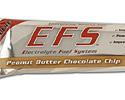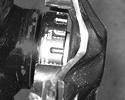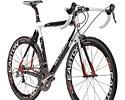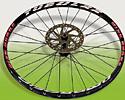
Recently on Cyclingnews.com |
Tech News – December 6, 2006Edited by James Huang Got tech? Send press releases, news, and tech questions to the Cyclingnews tech desk.
Truvativ GXP bottom bracket will be 73mm E-type compatible for ‘07For whatever reason, Truvativ’s Giga X Pipe external bearing bottom bracket system has been incompatible with E-type front derailleurs when used on a 73mm bottom bracket shell since its introduction several years ago. This hasn’t posed much of a problem for most, but those riders whose frame configurations required such a setup were simply forced to look elsewhere for crankset choices. The company is finally rectifying the situation for ’07 by adopting the now standard configuration of spacers, which will allow full compatibility will all bottom bracket shell width and derailleur combinations. Speaking of GXP and spacers, installation of the current configuration may seem a bit confusing to some users as it differs subtly from other systems. Truvativ’s GXP system is unique in the external-bearing bottom bracket world in that the bearings experience no additional preload during the installation process. Instead, the non-drive bearing is firmly captured on either side by the non-driveside crankarm and a shoulder on the bottom bracket spindle; the driveside bearing is thus free to 'float' on the spindle. In theory, this creates a lower friction setup with better durability. Incorrect spacer selection may instead result in unintentional preload on the driveside bearing when the crankarm is tightened down (which, by the way, should be bottomed out against the non-drive bearing and torqued to about 50 Nm). If the system binds before this point as you tighten the arm, chances are you’ve got it wrong.
Van Dessel jumps on the carbon fiber bandwagon for ‘07Van Dessel Cycles will introduce its first all-carbon road frame for 2007. The new Rivet will use 'tube-to-tube' construction similar to what Scott pioneered with its CR1 technology. This process is somewhat analogous to TIG-welding metallic frames where mitered carbon fiber tubes are mated together, wrapped with additional carbon fiber, and then cured to create a homogeneous structure with a claimed weight as low as 950g. In keeping with its aesthetically traditional tendencies, the Rivet will use a standard seatpost and headset arrangement. In spite of the competitively low weight that results from the carbon-wrapped construction, the process still requires significantly lower tooling costs as compared to some other methods such as monocoque or semi-monocoque. As such, Van Dessel plans to offer the Rivet to consumers with a surprisingly low US$1699 retail price.
Ambrosio tubular MTB rims and wheels
The tubular mountain bike wheel and tyre concept seems to be experiencing some renewed energy as of late as Italian firm Ambrosio recently launched not one, but three disc-compatible handmade MTB tubular wheelsets, all of which will use a new double-eyeletted alloy rim. The DT UL model is built using DT 240s hubs, 28 DT Aerolite spokes, and alloy Prolock nipples for a total claimed weight of 1520g for the pair. The DT model packs an additional 200g through the use of heavier straight 14g spokes and ABS nipples, while the XT version foregoes the DT hubs for Shimano XT models for a total claimed weight of 1910g for the set. With the popularity of modern tubeless setups and the benefits they already offer, it is inevitable that consumers will be skeptical of yet another system. For sure, tyre installation will be more difficult since they need to be glued (or taped) to the rim, and tyre swaps will clearly require a bit more than a passing thought. That being said, though, MTB tubular tyres are still substantially lighter than true UST-compatible rubber with some weighing well under 500g. Also, provided the glue job is up to snuff, there is virtually no chance of ‘burping’ air when running extremely low pressures. Will it catch on? We’ll see… |
 |
Cyclists have been bombarded with a dizzying array of electrolyte-enhanced sports supplements recently, but to date, all have only been available in liquid or tablet form. In response, First Endurance has now introduced its Electrolyte Fuel System (EFS) energy bar, which combines the same formula as its extant EFS drink with natural and (where possible) organic ingredients in a solid form.
According to First Endurance, each EFS bar is loaded with a wealth of (legal!) performance-enhancing supplements. These include: all five electrolytes in athlete-specific levels (over 1000mg per bar in total) to prevent cramping and dehydration; clinically effective doses of the amino acids glutamine, leucine, isoleucine, and valine to improve glycogen synthesis and delay fatigue; 200% RDA of vitamin C to enhance immune function; and a unique mix of maltodextrins and simple sugars that is said to be more readily absorbed and used by the body.
In total, each bar provides 250 calories, 10g of protein, 40g of carbohydrates, and 6g of fat. While we can’t attest to First Endurance’s performance claims, we can at least verify that its Peanut Butter Chocolate Chip flavor is not only easily digested, but tasty, too!
Photography
For a thumbnail gallery of these images, click here
Images by SRAM Corporation
- When properly installed, there should be no no gap between the non-drive crankarm and the non-drive bearing race, and the crankset should spin freely when torqued to about 50Nm.
- Truvativ's GXP system uses a "floating" driveside bearing; there should be a visible gap between the driveside arm and the driveside bearing when properly installed.
Images by Van Dessel Cycles
- Van Dessel's new Rivet is its first all-carbon offering, weighing in at just 950g and costing just US$1699.
Images by Ambrosio
- Ambrosio is hoping mountain bike tubular wheels and tires continue to grow in popularity. The system's light weight will likely appeal to cross-country racers.
Images by First Endurance
- First Endurance introduces its EFS energy, which it claims is the only bar on the market that supplies all five necessary electrolytes in meaningful quantities.




